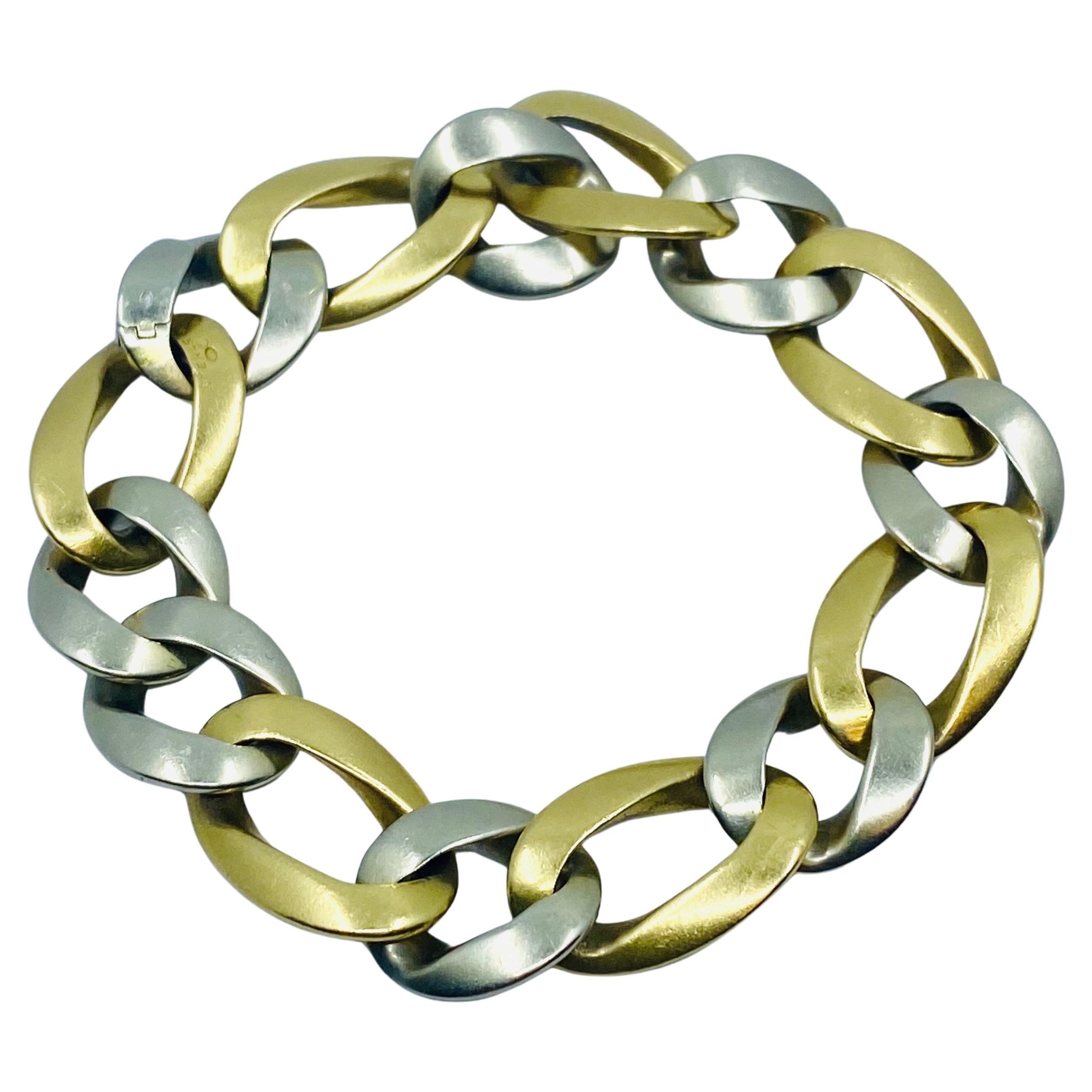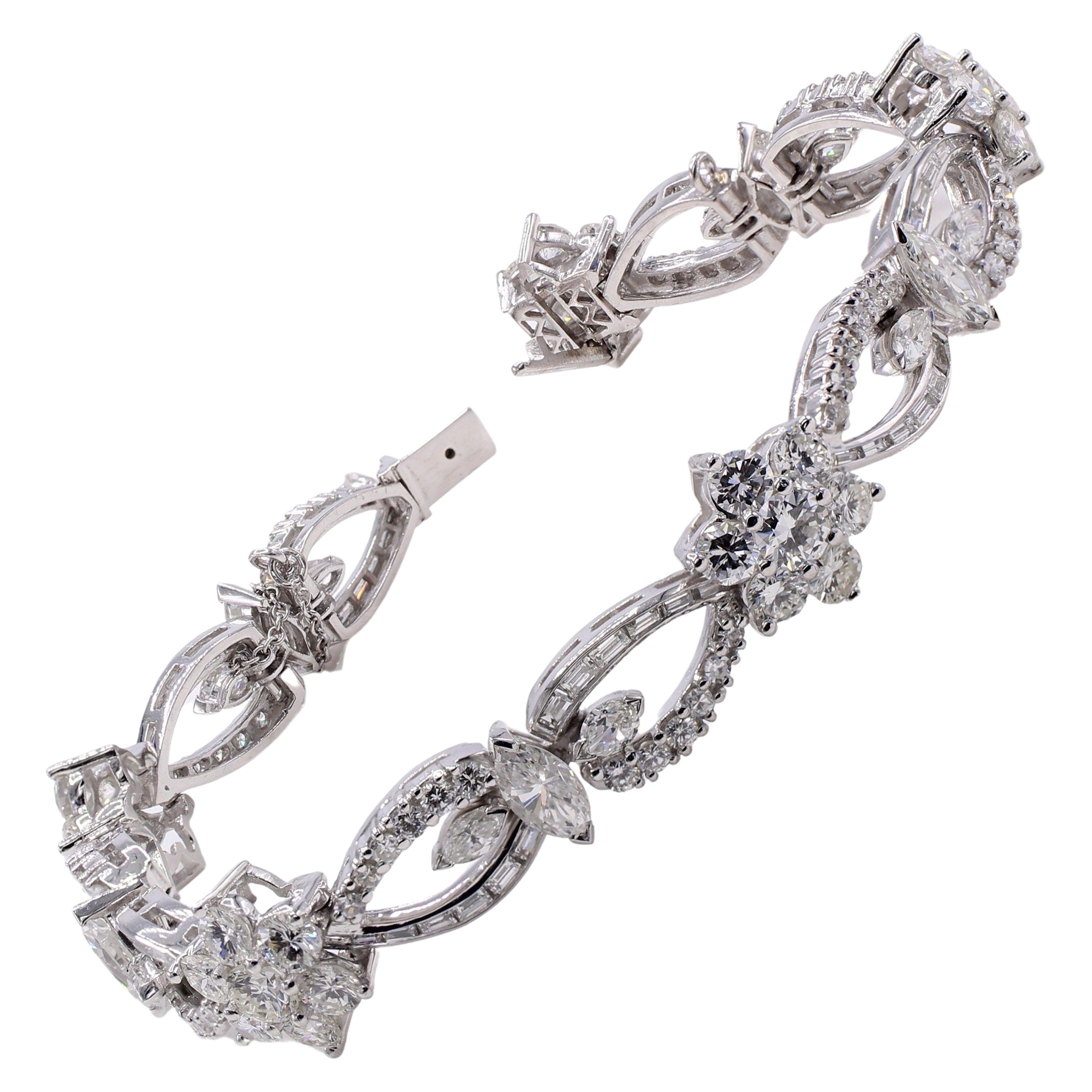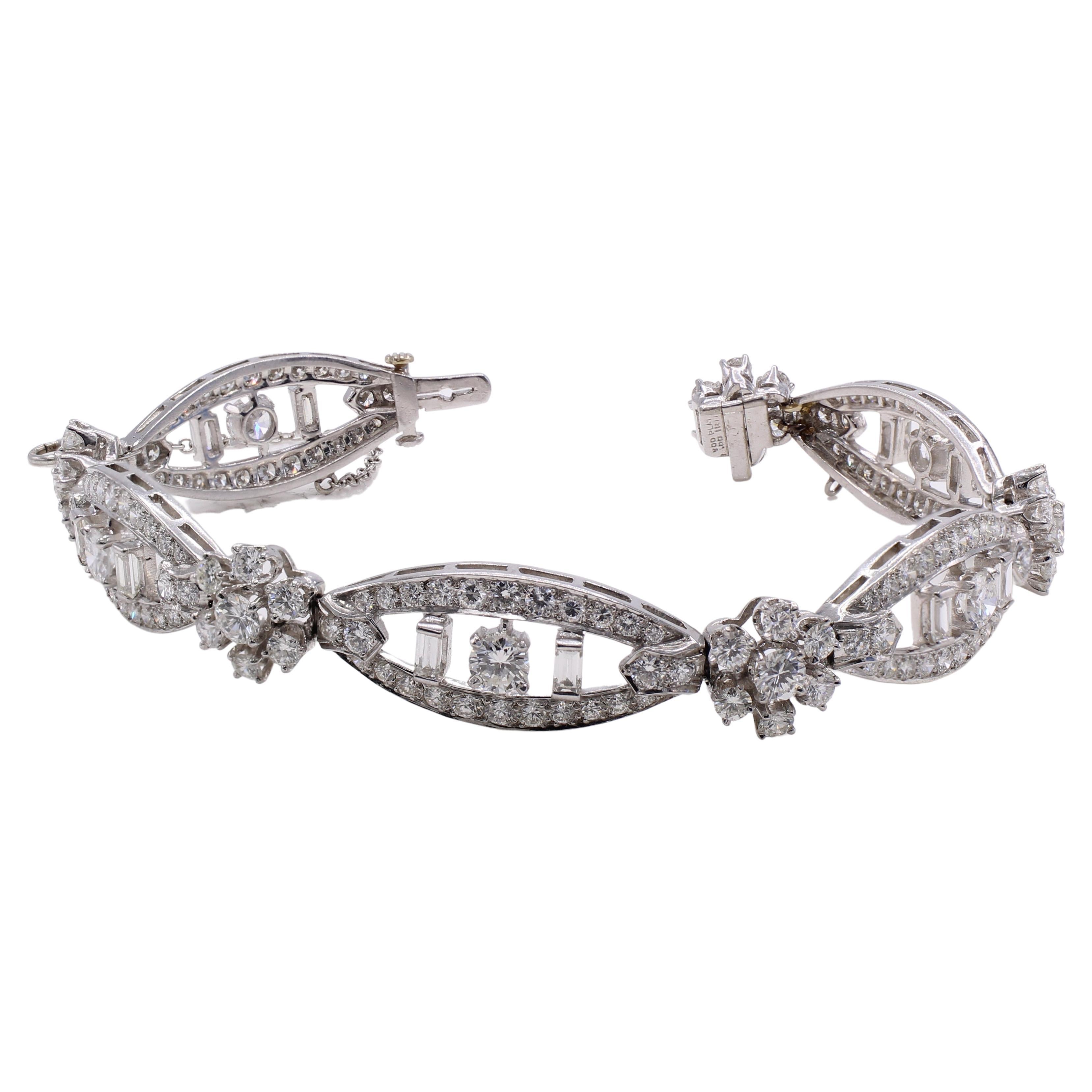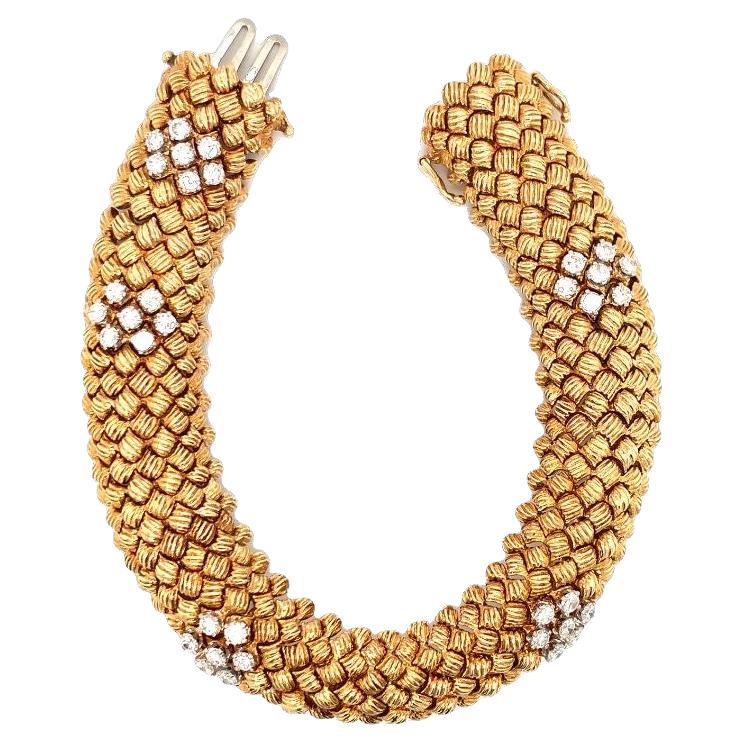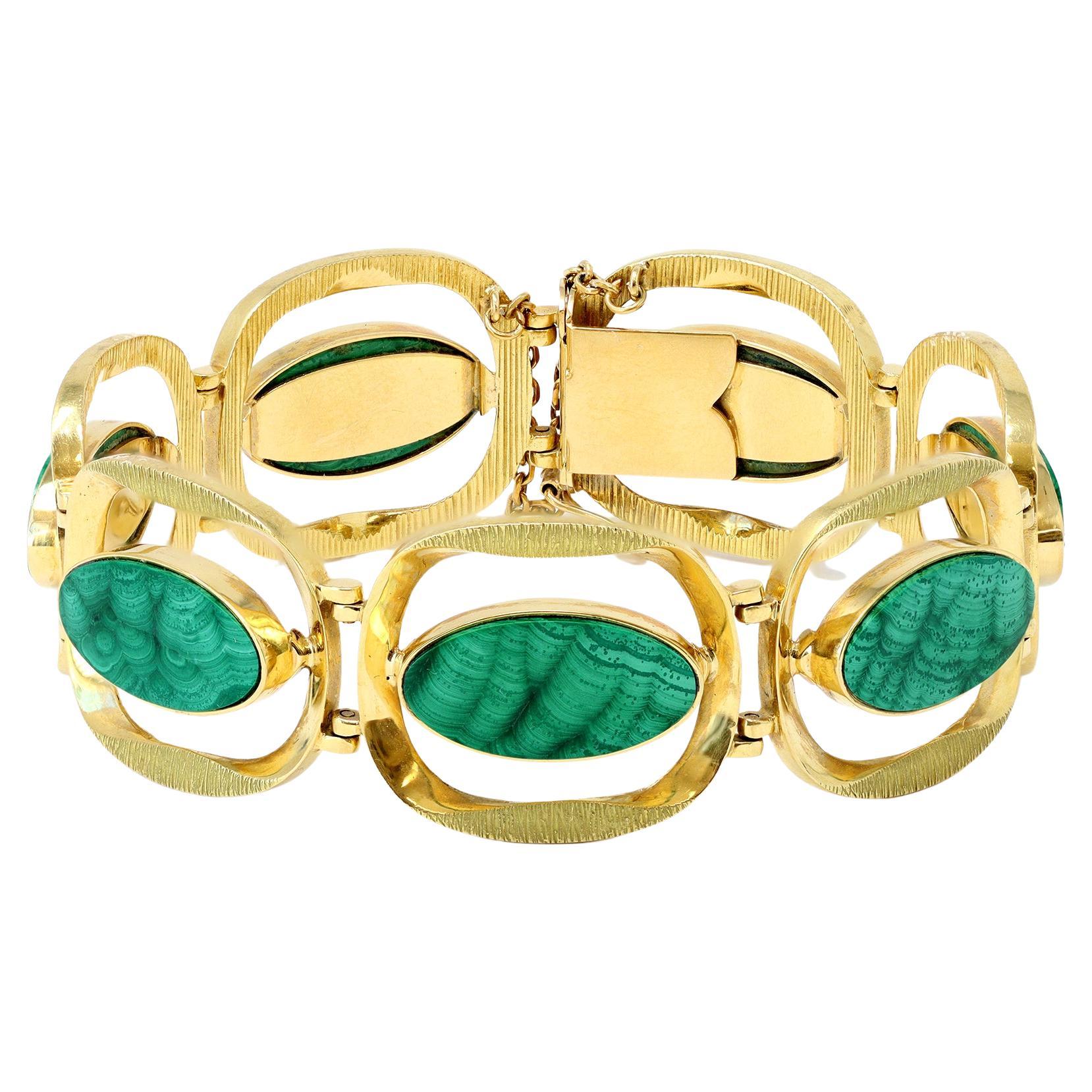Items Similar to 1960s signed Pierre Sterlé Bracelet - yellow gold and platinum.
Want more images or videos?
Request additional images or videos from the seller
1 of 8
1960s signed Pierre Sterlé Bracelet - yellow gold and platinum.
About the Item
Sterlé bracelet.
Made in France circa 1960. Made in 18k yellow gold and platinum. Signed and numbered - Sterlé PARIS 4132.
18cm long plus one extra link 2cm, 1.5cm wide.
Total weight: 76,7 grams
Pierre Sterlé,
1905 – 1978
Not a household name.
Pierre Sterlé not heard of him? Don´t feel bad. Pierre Sterlé, while not known to a wider public, is considered a highly important jewelry designer. His poetic, highly crafted pieces are some of the most distinctive designs of the 20th Century, and some of the most collectible. A widely respected name and an important figure in the luxury jewelry market. His pieces were produced for, and seen by, a select few.
Born in 1905 in Nice, France into a family of high-ranking financiers and Civil Servants, he was merely 10 years old when his father was reported missing, presumed killed, in the First World War. This great personal tragedy resulted in him being placed into the care of an uncle, Maynier-Pincon, who was a jeweler on the rue de Castiglione in Paris. He would, in time, become Sterlé’s tutor and mentor, training him in all aspects of the jewelry trade. In 1934 at the age of 29 Sterlé opened his own workshop on rue Sainte Anne and for the next five years he created jewelry for some of the most prominent Parisian houses such as Boucheron, Chaumet and Ostertag whilst simultaneously developing his own style. As his skill and reputation grew, he began to accept more individual commissions and by 1939 he was producing jewels exclusively for private clients.
As both his business and clientele grew, he took the decision to move to a more suitable and luxurious premises, opening an atelier workshop on the third floor of 43, Avenue de l’Opera in 1945. Sterlé, Like the jewelers at Boivin before him, and JAR after him, felt this was close enough to the Place Vendôme to be convenient for his increasingly wealthy and fashionable clients but still far enough away for him to be able to maintain his sense of elitism. He had no interest in running a ground floor boutique which was open to the public and with windows in which to display his jewels to anyone who happened to be walking past. It was, for socialites and royalty alike, by appointment only.
A man of great personal charm and grace he saw himself as separate from the large jewelry houses and sought to create an aura of exclusivity and prestige for his work.
Customers and collectors came from all over the world, and he undertook some historically important commissions including being asked to remodel the crown jewels of Egypt by Queen Narriman.
Whilst he never actually drew the designs himself, Sterlé employed highly talented designers to translate his creative imaginings into technical designs for the craftsmen to execute. He strongly opposed the jewel as a mere financial asset. He was inspired by nature and the shapes and forms found therein but refused to be constrained by the formal rigidity of metal and gemstones which he sought to manipulate and infuse with movement and life. Achieving remarkable fluidity and intriguing asymmetry, bringing them a sense of movement and the difficult-to-achieve combination of glamour and ease.
He created innovative jewels using the rich tones of yellow gold paired with gemstones which he valued for their color and artistic impact. He playfully combined the vibrant tones of coral, lapis, turquoise, sapphire and peridot amongst others. However, he also had a strong inclination towards the purity of white metal and diamonds, often contrasting the lively sparkle of brilliant cut diamonds with the clean geometry of baguette cuts in the same piece. His diamond jewels won him the prestigious De Beers Diamond Corporation’s ‘Diamond Award’ not once but in three consecutive years in 1953, 1954, and 1955.
He was renowned amongst his peers for his technical expertise, often treating gold as if it were fabric, twisting, knotting and plaiting it to create texture and movement in his jewelry like no other jeweler. In 1957 he invented a new way of working with gold called ‘fil d’ange’ or ‘angel wire’ knitting it into fine ropes which he used to create fringes. These became a distinctive element of his jewels.
Sterlé achieved great success both at home and abroad during the 1940’s and 50’s with clients including some of the most significant jewelry collectors of the period such as King Farouk of Egypt, the Maharani of Baroda and the Begum Aga Khan. Some of Sterlé's most famous designs include the "Zip" necklace, which he created for the Duchess of Windsor in the 1950s, and the "Ballet" necklace, which was inspired by the movements of ballet dancers. Despite this however, a series of professional and personal misfortunes and miscalculations including a failed attempt to branch out into perfume saw Sterlé’s fortunes fall dramatically and in 1961 he had to sell many of his designs to Chaumet as well as some to New York jeweler Montreaux. He recovered, and as the first modern jeweler to be invited to do so, staged a very successful display at the 1966 Paris Biennale. This contributed directly to a decision, against all his previous reasoning, to open a store front in 1969 on the rue Saint-Honoré. Unfortunately, his earlier misgivings were proved right, and the shop was ultimately unsuccessful, forcing him to declare bankruptcy and liquidate his stock in 1976. Most of it was bought by Chaumet, who commenced signing anything that was not already so, resulting in pieces as early as 1962 now having a Chaumet signature. Sterlé stayed on as a technical consultant with Chaumet until his death in 1978.
- Creator:
- Metal:
- Weight:76.7 g
- Dimensions:Width: 0.6 in (15 mm)Length: 7.09 in (180 mm)
- Style:
- Place of Origin:
- Period:
- Date of Manufacture:1960s
- Condition:Additions or alterations made to the original: It has been shortened. Wear consistent with age and use.
- Seller Location:Malmö, SE
- Reference Number:1stDibs: LU3148220277052
Possible to extend by an extra link.

About the Seller
5.0
Recognized Seller
These prestigious sellers are industry leaders and represent the highest echelon for item quality and design.
Platinum Seller
These expertly vetted sellers are 1stDibs' most experienced sellers and are rated highest by our customers.
Established in 2015
1stDibs seller since 2022
31 sales on 1stDibs
Typical response time: 1 hour
- ShippingRetrieving quote...Ships From: Malmö, Sweden
- Return PolicyA return for this item may be initiated within 3 days of delivery. Please be advised, certain types of customizations are not eligible for returns.
More From This SellerView All
- 1960s Georges L’Enfant 18k gold braceletBy Georges L'EnfantLocated in Malmö, SEFrom France’s most revered goldsmith. The intricately woven links of a Georges L’Enfant bracelet are recognizable at once. The highly skilled gold master spun art from gold, creatin...Category
Vintage 1960s French Modern Link Bracelets
Materials18k Gold
- 1970s sculptural erotic 18 karat yellow gold necklace and bracelet suiteLocated in Malmö, SEDefinitely a conversation piece. Lots of attitude without being in your face. A sculptural erotic 1970s 18K gold necklace and bracelet suite. Drawing inspiration from Jean Mahies, Jean Filhos...Category
Vintage 1970s French Retro Link Bracelets
MaterialsGold, Yellow Gold
- Hermès necklace and bracelet set -1970s yellow gold nautical rope knot linkBy HermèsLocated in Malmö, SESo very fab! Rare 18K Yellow Gold Nautical Rope Link necklace and bracelet set by Hermès An 18 karat yellow gold necklace and bracelet set with rope-like links, a loop of twisted gold wire, the iconic Hermès knot...Category
Vintage 1970s French Retro Link Necklaces
Materials18k Gold, Yellow Gold
- 1940s mariner rope anchor chain 18 karat yellow gold braceletLocated in Malmö, SEThis is nautical bracelet holds its own! It incorporates the ships hefty ropes with the steady large anchor chain. French gold marks for 18 karat. Illegible maker's mark, but I have ...Category
Vintage 1940s Italian Modern Link Bracelets
Materials18k Gold, Yellow Gold
- Vintage 1990s Carl Bucherer link bracelet two color 18 karat goldBy BuchererLocated in Malmö, SEVintage 1990s Carl Bucherer link bracelet 18 karat gold. Can be worn alternately with alternating yellow gold and white gold links on one side and yellow gold links on the other. 0.43 inch / 11 mm wide, box clasp with safety clasp, length 7.36 inch / 18.7 cm, signed CB, Weight 25,2 grams. About Bucherer: Blending the art of jewelry-making with exquisite watchmaking expertise- The Bucherer Fine Jewelry story began in 1888 when Carl F. Bucherer opened his first jewelry and watch shop in Lucerne, Switzerland. Carl Friedrich and his wife Louise wanted to seize the opportunity offered by an influx of wealthy tourists who came from all over Europe to admire the Alps and take in the fresh mountain air. The Bucherer store...Category
1990s Swiss Modern Link Bracelets
MaterialsGold, 18k Gold, White Gold, Yellow Gold
- Antique old world belle époque emerald and diamond braceletLocated in Malmö, SEAntique old world Belle époque emerald bracelet, Alluring and mesmerizing darkened silver accentuated by lush deep green emeralds. An elegant e...Category
Antique Late 19th Century European Link Bracelets
MaterialsDiamond, Emerald, Gold, 14k Gold, Silver
You May Also Like
- Pierre Sterlé Gold Link BraceletBy Pierre SterléLocated in Beverly Hills, CADesigner: Pierre Sterlé Materials: 18 karat Yellow and White Gold Weight: 50.9 grams Measurement: 7 1/2" x 1/2" Hallmarks: STERLE A stylish Pierre Sterlé link bracelet made of 18k ...Category
Vintage 1950s French Link Bracelets
MaterialsGold, 18k Gold
- 1960s Vintage Yellow Gold BraceletLocated in Jesmond, Newcastle Upon TyneAn impressive vintage 1960s 9 karat yellow gold bracelet; part of our diverse vintage jewelry and estate jewelry collections. This fine and impressive vintage bracelet has been crafted in 9k yellow gold. The fully articulated bracelet is composed of twenty-eight rectangular links, embellished with a hand engraved floral design. The reverse of each individual link is hallmarked with the 9k gold fineness mark (9.375). The bracelet secures with a discreet integrated push fit clasp and benefits from the additional security of a fine link safety chain and catch. The push fit clasp is hallmarked to the reverse with partially worn but legible marks, including the maker's mark for T&H Crathorn Ltd (T&HC), the 9k gold fineness mark (9.375) and the Birmingham Assay Office hallmark (anchor). The catch to the safety chain is struck with the mark for 9k gold (9CT). Condition This impressive vintage yellow gold bracelet...Category
Vintage 1960s British Retro Retro Bracelets
MaterialsGold, 9k Gold, Yellow Gold
- 1960s Diamond Platinum Cocktail BraceletLocated in New York, NYBeautifully designed and masterfully handcrafted, this 1960s platinum bracelet is decoratively set with round, marquis and baguette cut diamonds. The flexible sections sparkle and sh...Category
Vintage 1960s Link Bracelets
MaterialsDiamond, Platinum
- 1960S Diamond Platinum Cocktail BraceletLocated in New York, NYWonderfully handcrafted 1960s platinum diamond cocktail bracelet. 5 flexible oval sections set with round and baguette cut diamonds and spaced by 5 rosette shaped sections set with r...Category
2010s Link Bracelets
MaterialsDiamond, Platinum
- Diamond and 18k Yellow Gold Bracelet, circa 1960sLocated in Beverly Hills, CAOne diamond 18K yellow gold bracelet with individual textured gold links featuring 35 round brilliant cut diamonds totaling 2.25 ct. Circa 1960s. Exquisite, bold, substantial. Addi...Category
20th Century Link Bracelets
MaterialsDiamond, 18k Gold, Yellow Gold
- 1960s Malachite and Gold BraceletLocated in Miami, FLYellow gold and malachite bracelet, circa 1960, designed as a series of semi circular textured gold links set in the center with oval malachite sections. The gross weight of the brac...Category
Vintage 1960s Link Bracelets
MaterialsMalachite, Gold, Yellow Gold
Recently Viewed
View AllMore Ways To Browse
Peridot Bracelet In Yellow Gold
Ballet Charm Bracelet
50s Charm Bracelet
Jared Rue
Coral Bracelet 18k Yellow
Yellow Gold Wire Diamond T Necklaces
Vintage Gold Angel Bracelet
Chaumet Bracelet Diamond
18k Yellow Saint Charm
Branch Bracelet
Platinum And Lapis Bracelet
Jewelers Trade Sign
Chaumet White Gold Bracelet
Pierre Sterle Jewellery
1960 Turquoise Bracelet
Man Bracelet Jewelry
Vintage Sapphire Necklace Gemstone
Vintage Angel Diamond Bracelet
